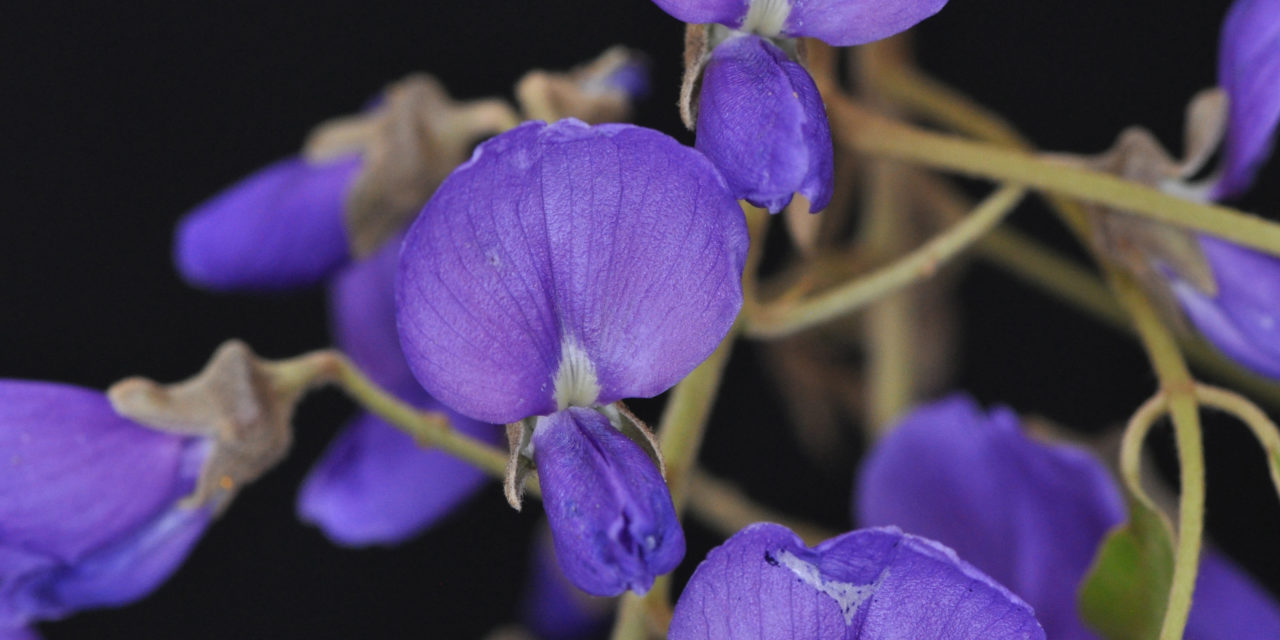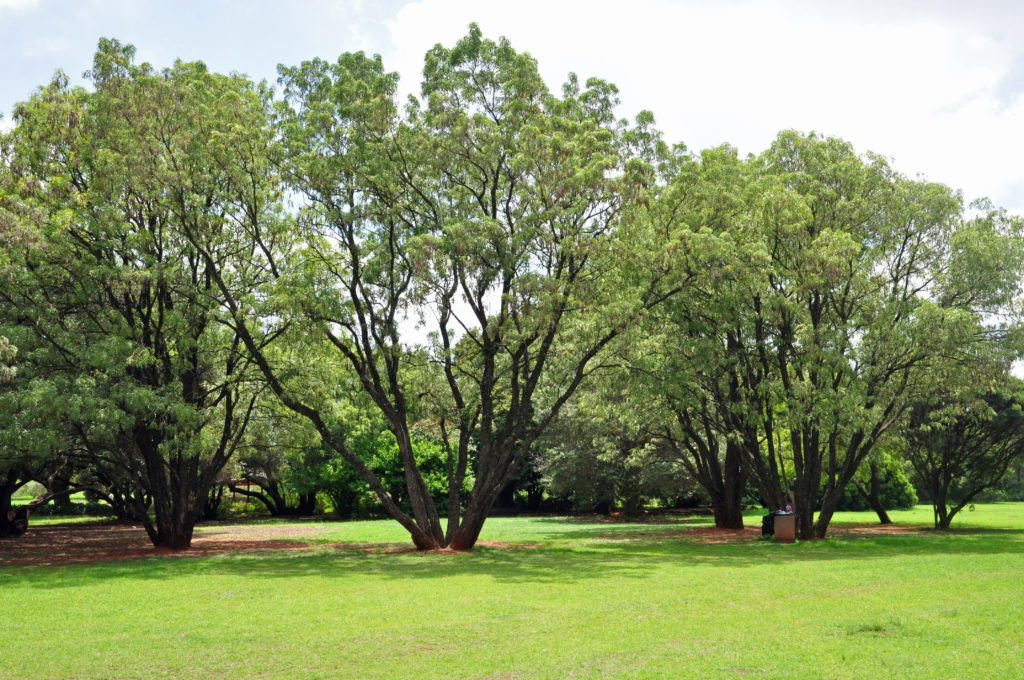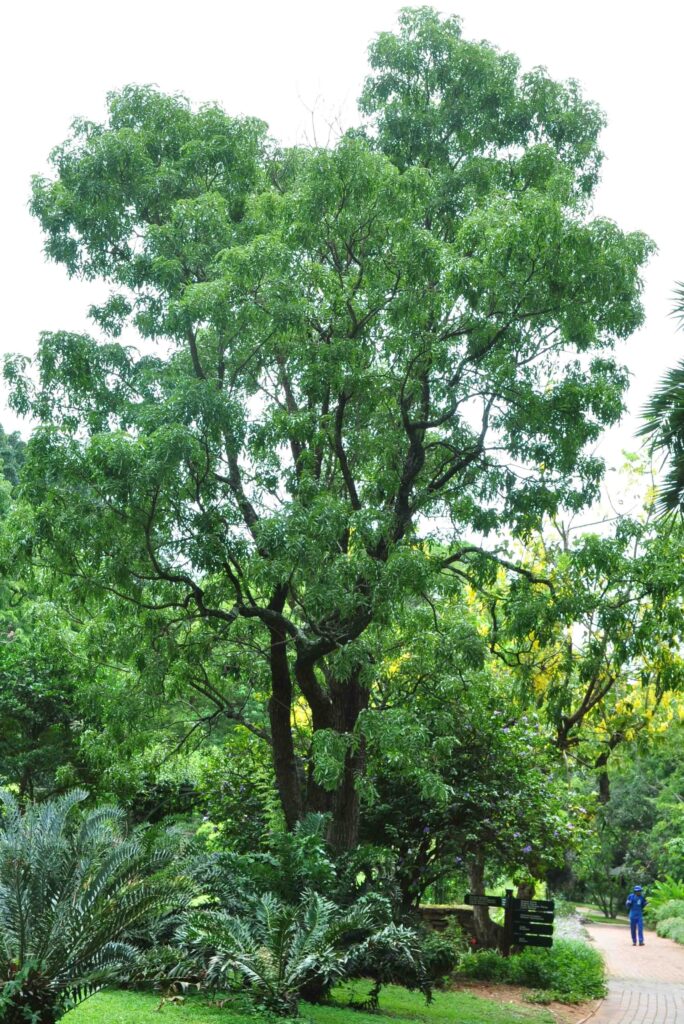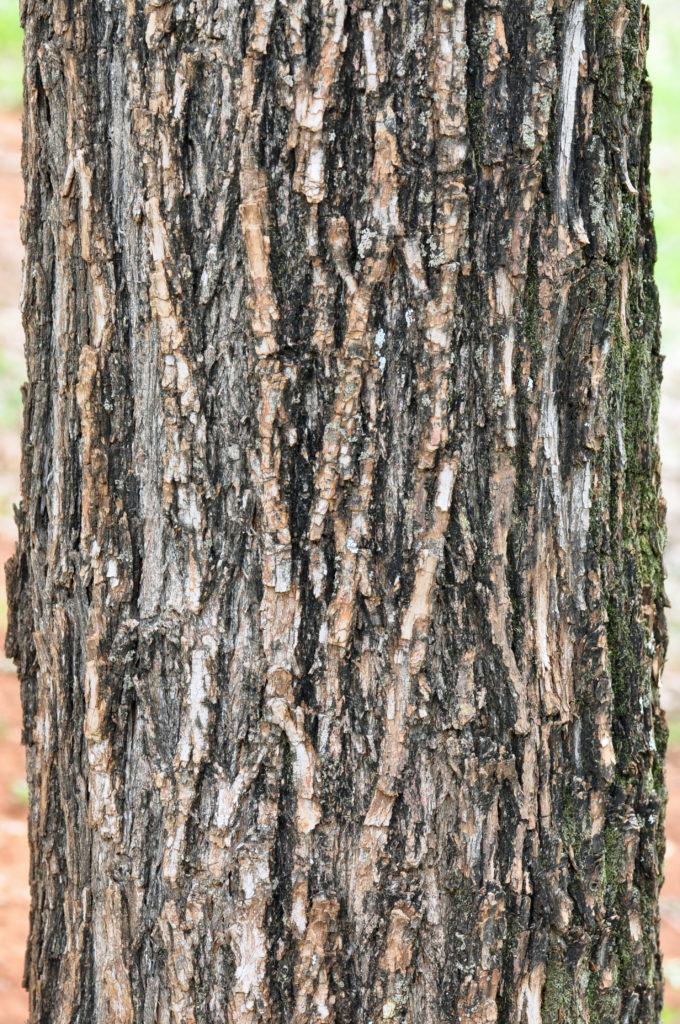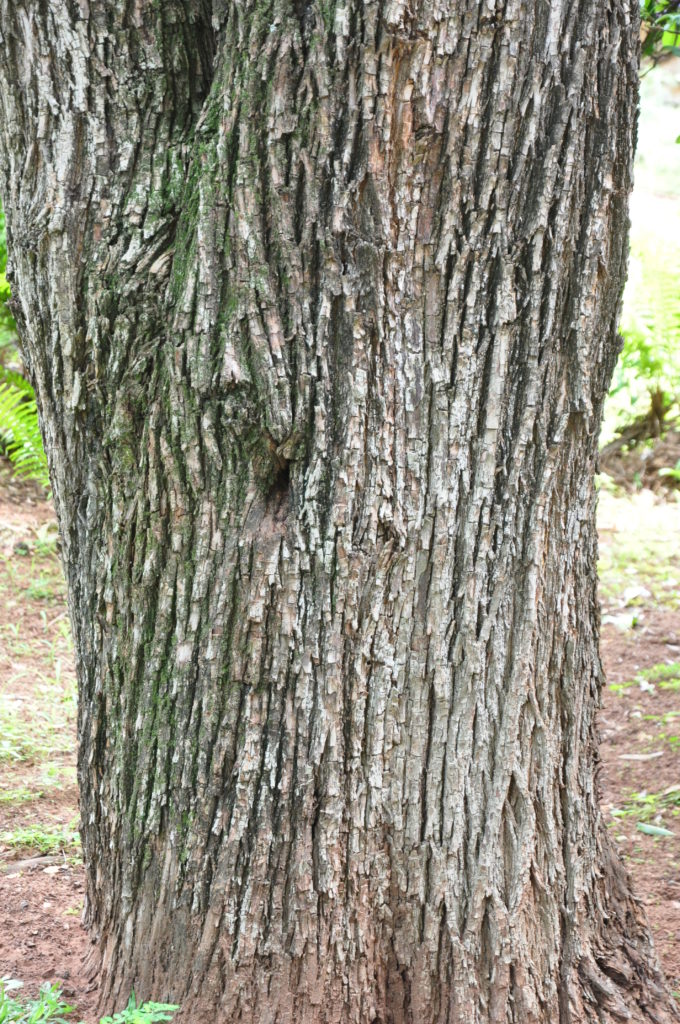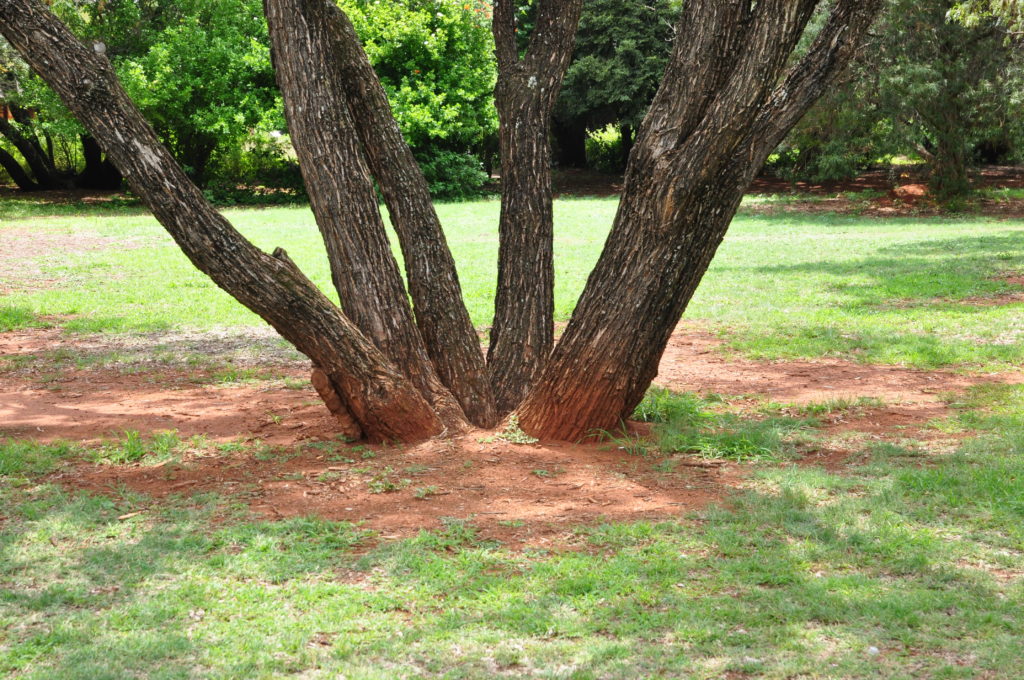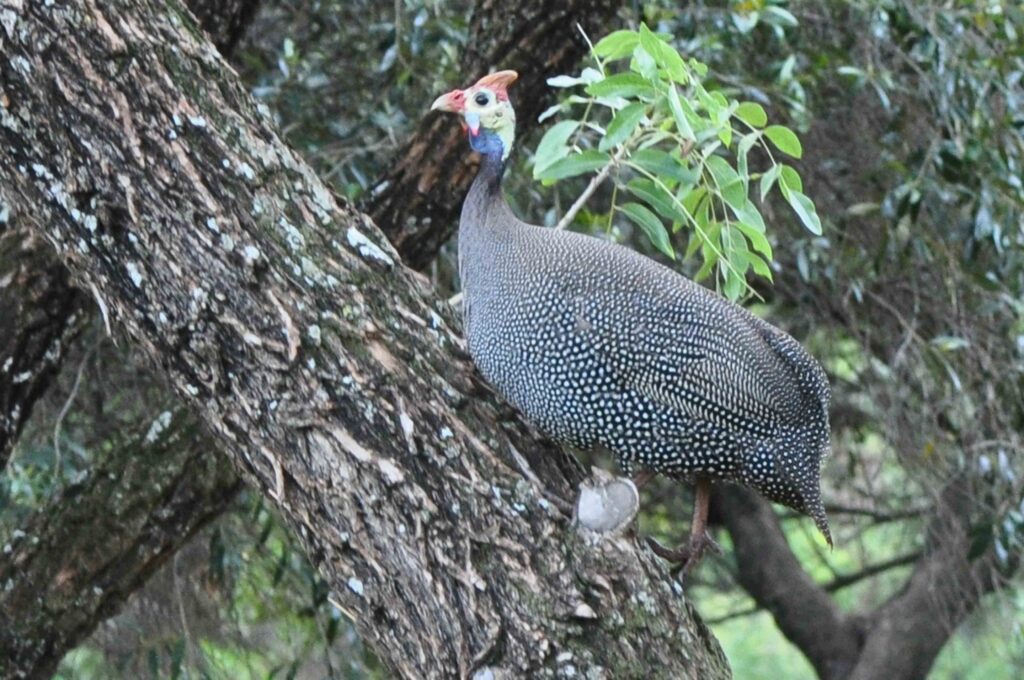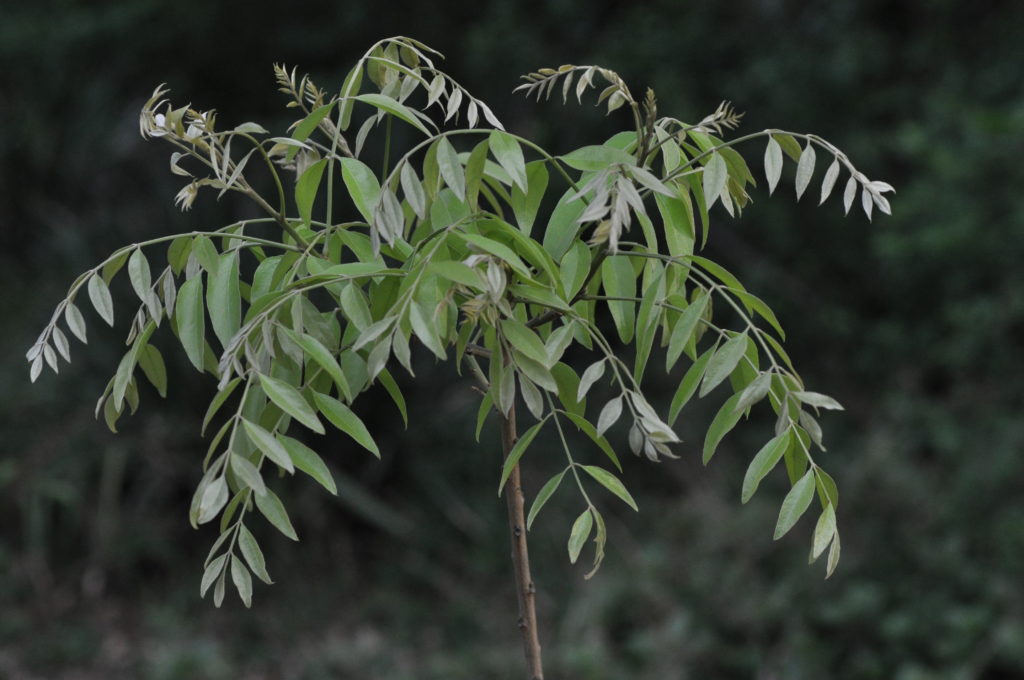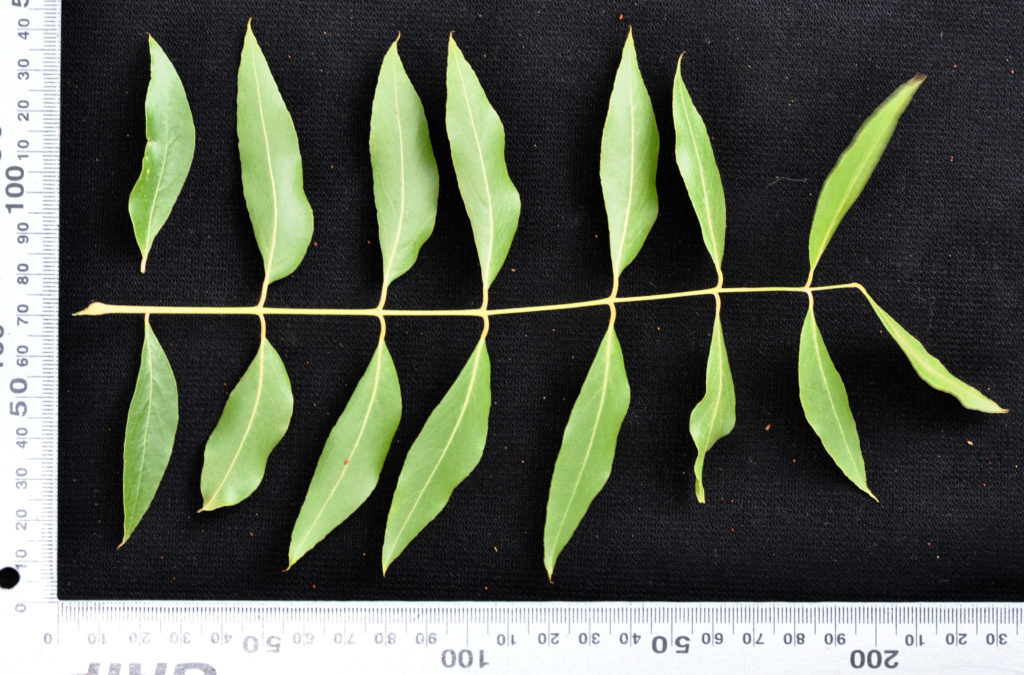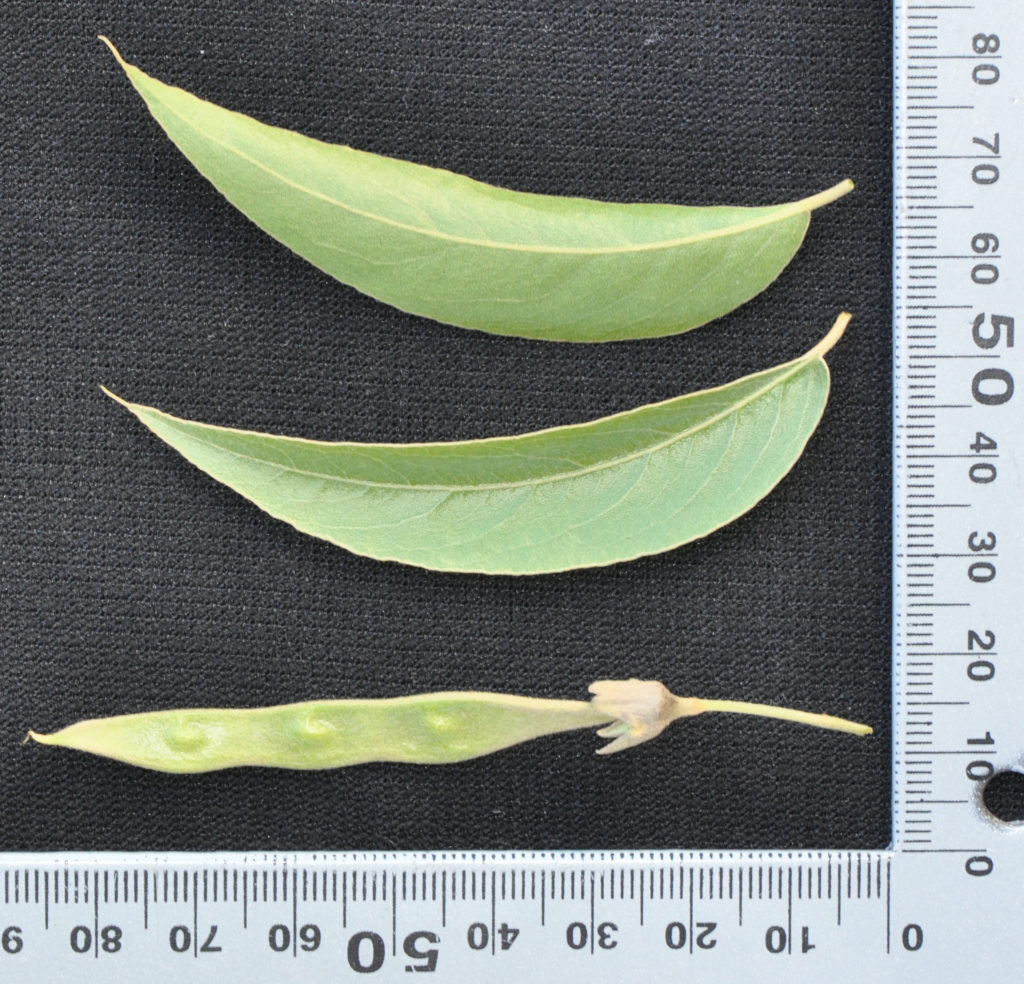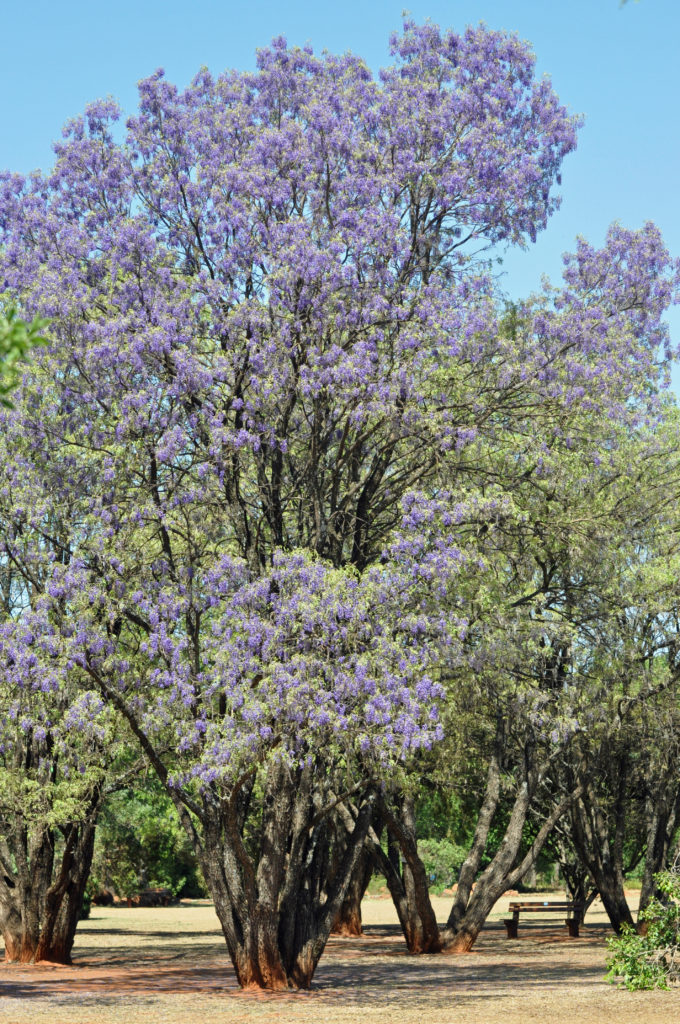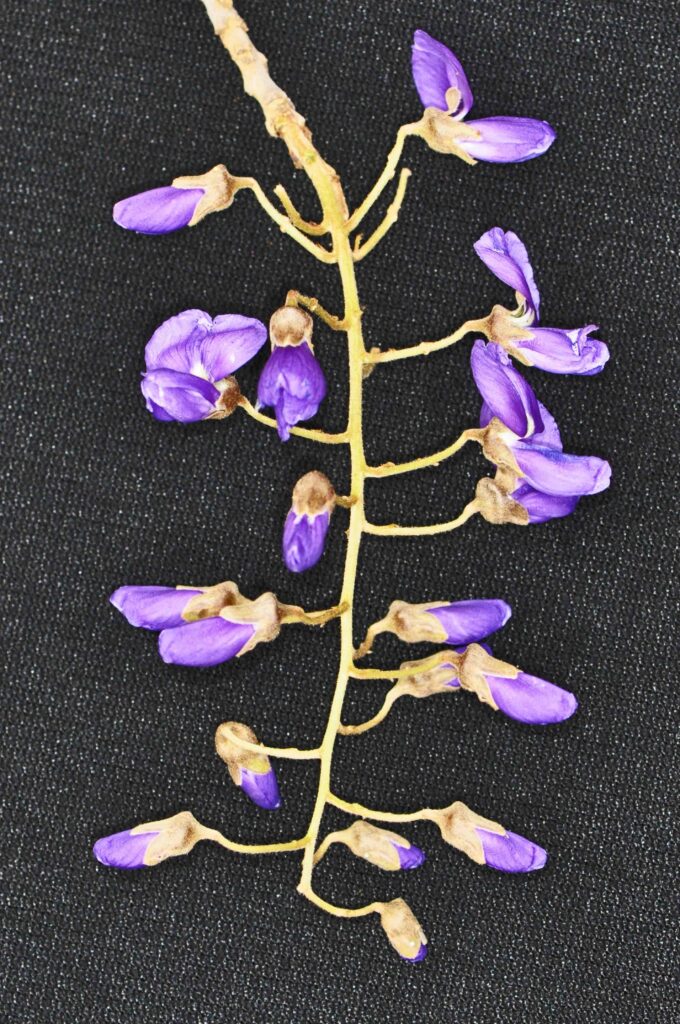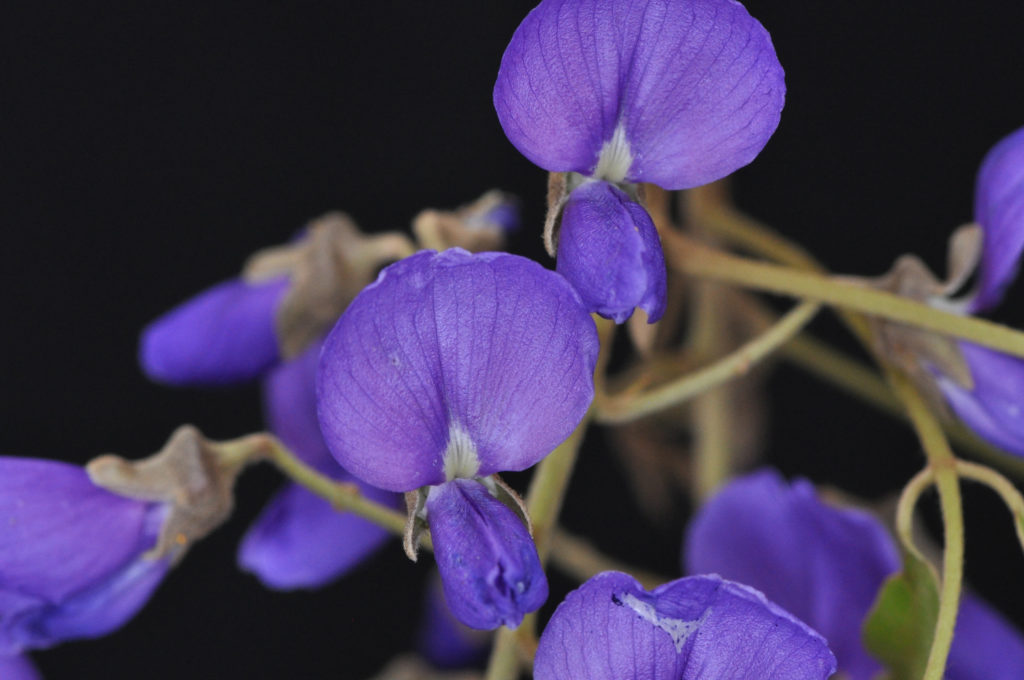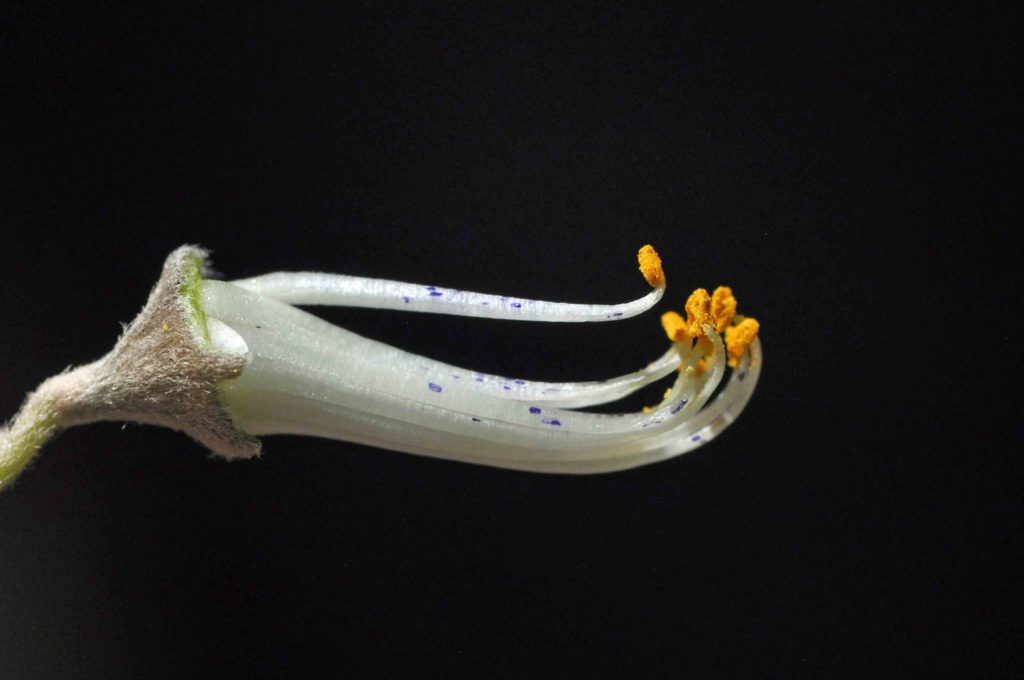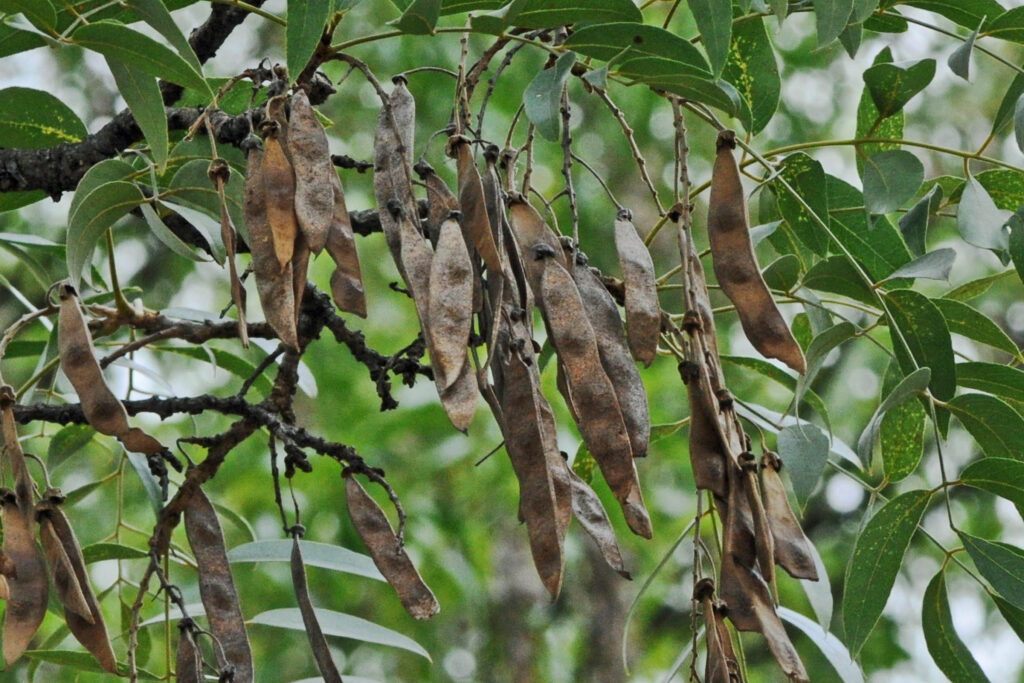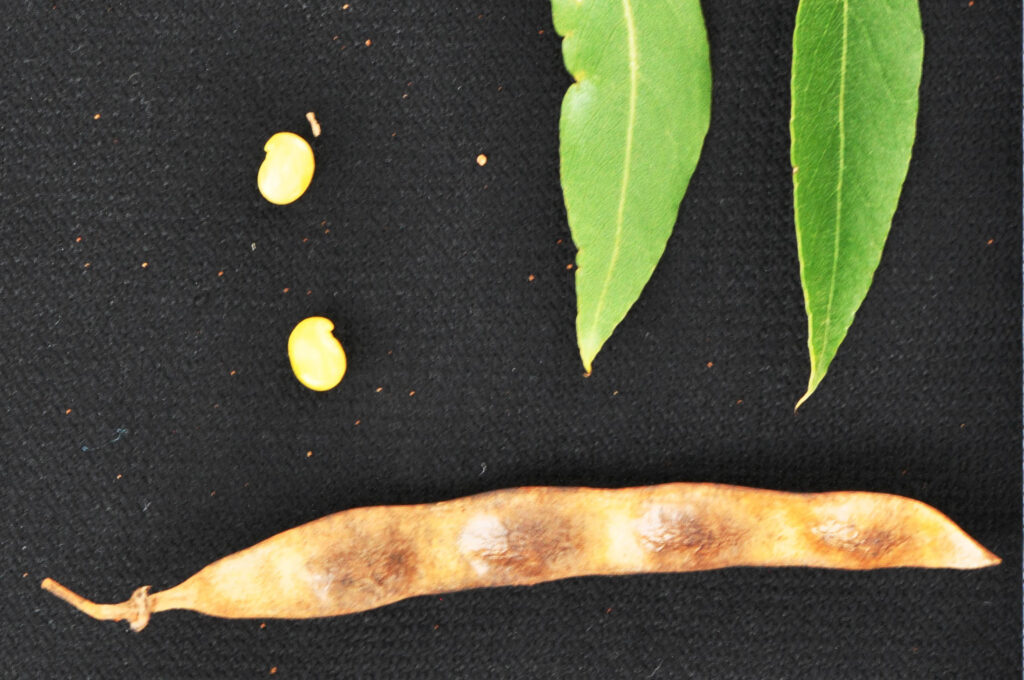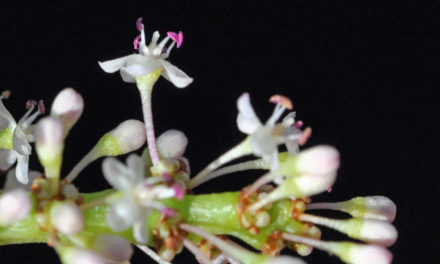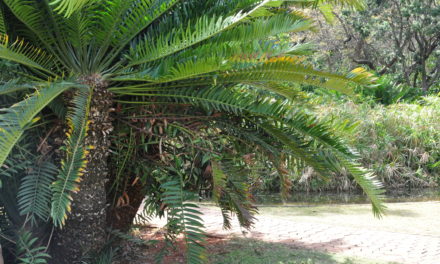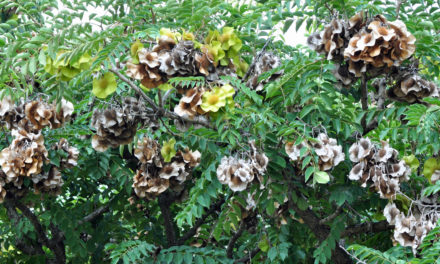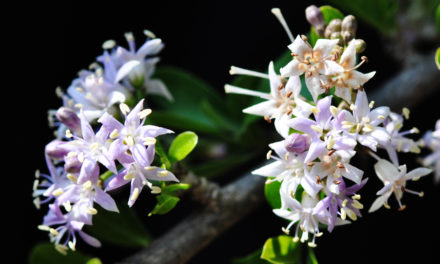Bolusanthus speciosus
General Info – summary
This graceful Tree is up to 12m high. Mature bark is deeply longitudinally grooved. The imparipinnate Leaves have paired lanceolate leaflets. The blue, pea-like, bisexual, zygomorphic, 5-merous Flowers are in racemes – each with 9 joined and 1 free stamen. The single pistil has a superior ovary with a single curved style and a capitate stigma. The flattish, papery Fruit is a brown, tardily dehiscent pod with shiny seeds.
Description
Previous Names: Lonchocarpus speciosus.
SA Tree No. 222.
Common names: (Afr) Olifantsboom, Olifantshout, Vanwykshout. (Eng) Elephant Wood, Elephant’s Wood, Rhodesian Wisteria, South African Wisteria, Tree Wisteria, Wild Wisteria. (isiZulu) Umhohlo. (Northern Sotho) Kgomo-nahlabana, Mogapa. (Setswana) Mosôkaphala, Motsokophala. (siSwati) Umhohlo. (Tshivenda) Mukamba, Mukambana, Muswinga-phala. (Xitsonga) Mpfimbahongonyi.
Family: Fabaceae, or Leguminosae (Pea, bean or legume family). After the Orchidaceae and the Asteraceae, the Fabaceae is the third largest Angiosperm (flowering plants) family with 700+ genera and close to 20 000 species. Local Tree genera on this website include Acacia (Vauchellia, Senegalia), Albizia, Bauhinia, Bolusanthus, Burkea, Calpurnia, Colophospermum, Cordyla, Cyclopia, Dichrostachys, Erythrina, Erythrophleum, Faidherbia, Indigofera, Mundulea, Peltophorum, Philenoptera, Piliostigma, Schotia and Xanthocercis. The Fabaceae are recognisable by their fruit and their pinnately compound Leaves. Leaves may also be simple – even bilobed and usually have stipules – some of which may be spinescent. Leaflets are usually entire. Flowers are bisexual and bracteate. Regular flowers usually have 4-5 sepals and the same number of petals. Irregular flowers have 4-5 sepals and 5 or less petals. Stamens have anthers that have 2 pollen sacs and there are usually at least twice the number of stamens as petals – often 10. The superior Ovary has 1 locule containing 1 or more ovules. The Stigma and Style are simple. The single carpel develops into the Fruit, which is usually a pod. The mature pods may dehisce or break into segments. Seeds vary.
Name derivation: Bolusanthus named after the founder of the Bolus Herbarium in Cape Town: the Englishman Dr Harry Bolus 1834-1911. He was a botanist, a botanical artist, businessperson and philanthropist. Five genera carry his name. speciosus – spectacular / showy / beautiful – referring to the flowers. Bolusanthus speciosus was first collected in Mozambique and is the only species in this genus.
Conservation: National Status: L C. (Least Concern). Assessed: 2005/06/30 (W. Foden and L. Potter).
Tree
With its normally narrow Crown, this impressive often single trunked Tree (photo 227) is usually up to 6m high but may reach 12m. The Trunk is up to 38cm wide and is usually straight. When multi stemmed (photo 238); the stems remain straight but emerges from the ground at an angle (photo 239). Young branches are light to dark brown or grey. Mature Bark is rough and deeply fissured longitudinally (photos 225 & 228).
- 238. 2016/01/26. Pretoria NBG. Photo: David Becking.
- 227. 2015/02/09. Durban BG. Photo: David Becking.
- 225. 2016/01/26. Pretoria NBG. Photo: David Becking.
- 228. 2015/02/09. Durban BG. Photo: David Becking.
- 239. 2016/01/26. Pretoria NBG. Photo: David Becking.
- 217. 2016/01/26. Pretoria NBG. Photo: David Becking.
Leaves
The shiny Leaves of this graceful tree develop at branch ends and tend to droop (photo 250). Young leaves are a silvery bronze (photo 250). Mature leaves are a bright shiny green above, lighter and a duller green below (photo 017). On a sunny day, minute silvery hairs on the upper surface make the leaves visible from a distance. Each reasonably opposite leaf is imparipinnate (compound leaf ending in a single leaflet – photo 227). The Petiole (leaf stalk) is up to 13mm long and has a thickened base (photo 227). The leaf contains between 3 and 7 pairs of nearly opposite leaflets and the single terminal one. Each leaflet is up to 7,5 x 2,5cm and has a distinct Petiolule (stalk of leaflet) that is about 5mm long (photos 227 and 017). Stipules (basal appendages of the petiole) are present. The tree usually holds its leaves until just before the flowers open and the emergence of the new silvery bronze leaves (photo 250). The lanceolate Leaflets are jugate (having leaflets in pairs – each pair attached to the single leaf Rachis: main axis of a compound structure -an extension of the petiole – photo 227). Each leaflet measures up to 70 x 16mm. Lateral veins may be yellowish and are slightly more visible below. The Margin is minutely scalloped (photo 017 – observe carefully). The distinctive Midrib is pale yellowish and protrudes slightly below (photo 017). The Apex is narrowly tapering and ends in sharp point (photo 017 & 228 under Fruit). The Base is broadly tapering to rounded and markedly asymmetric (not equal to the opposite side) causing the leaflets to curve (photo 017. This tree may be briefly deciduous.
- 250. 2017/10/02. Pretoria NBG. Photo: David Becking.
- 227. 2016/01/26. Pretoria NBG. Photo: David Becking.
- 017. 2016/10/25. Pretoria NBG. Photo: David Becking.
Flowers
The impressive, violet to blue Flowers develop in large, (up to 30cm long) pendulous inflorescences called Racemes (simple, unbranched, indeterminate inflorescences with pedicellate – stalked flowers – photo 933), along the axis that open in succession towards the apex – photo 933). They arise before or with the new leaves and flowering branches may almost cover the tree (photo 868). The individual scentless 5-merous (having a specific number of parts – in this case 5) flowers are pea-like, bisexual and zygomorphic (irregular flower with the corolla divisible into 2 equal halves in one plane only). The bell-shaped Calyx has 5 Sepals (photo 933) with the 2 uppermost joined high up. The Corolla has 5 Petals. The largest upper petal (standard or vexillum petal) stands vertically outside the rest. It is much broader than other petals and has an impressive, distinctive white patch in its central base (photo 921). Below this are a pair of lateral petals – the wing petals. At the base, there are 2 joined keel petals which are as long as the wing petals. There are 10 Stamens (photo 503) of which 9 have joined filaments and the tenth, uppermost one, is free (photo 503). Here the white Filaments may have attractive blue dots and bend sharply upwards near the end to place the Anthers perpendicular to the ground thus aiding pollen dispersal in the process. The versatile (hung or attached near the middle, and usually moving freely) and elliptic anthers are a golden colour – at least initially. There is a single Pistil (a unit of the Gynoecium, the female element of the flower, composed of the Ovary, Style and Stigma). Here the superior Ovary with up to 8 ovules extends into a single curved Style which ends with a small capitate (shaped like a head) Stigma (the part of the pistil that receives the pollen). (Aug-Dec).
- 868. 2016/10/11. Pretoria NBG. Photo: David Becking.
- 933. 2016/10/18. Pretoria NBG. Photo: David Becking.
- 921. 2016/10/18. Pretoria NBG. Photo: David Becking.
- 503. 2017/10/17. Pretoria NBG. Photo: David Becking – dissected.
Fruit
The belatedly dehiscent Fruit is a narrow papery, down hanging clusters (photo 230) of flattish Pods. Each is up to 9 x 1,2cm and develops up to 8 shiny Seeds. The dry brown or straw-coloured pods are papery (photo 230) and may turn black. The remains of the Calyx is still visible on the maturing pods (photos 228 & 017 – under Leaves). The leathery seeds resemble those of beans (photo 228) and cause the pod to bulge slightly. In this photo, the short remains of the style is just visible at the apex of the pod. (Oct-Mar+).
- 230R. 2016/01/26. Pretoria NBG. Photo: David Becking.
- 228. 2016/01/26. Pretoria NBG. Photo: David Becking.
Distribution & Ecology
The Roots are non-invasive and do well in clay soils. This Plant tolerates a wide variety of soils and is common in wooded grassland, at low to medium altitudes and in savanna (a rolling grassland scattered with shrubs and isolated trees, which can be found between a tropical rainforest and desert biome). In South Africa, these plants occur naturally in, Limpopo and northern Mpumalanga along the foothills of the nearly 130km long W-E Soutpansberg mountains. They also occur in KwaZulu-Natal, Gauteng, Eswatini (Swaziland), Mozambique (mainly central and south), Zimbabwe, Botswana, Malawi, and Angola and are endemic in southern Africa. Vervet monkeys (Chlorocebus pygerthrus) eat the flower buds. Monkeys in general, gemsbok, giraffe and grey duiker eat the Fruit and Leaves. Helmeted guineafowl in the genus Numida can have a relatively safe night on the multi stemmed, leaning over branches of this tree (photo 217 under Tree). Scale insects may infect the tree, and their presence causes small bumps on plant stems.
Ethnobotany
Bolusanthus speciosus is a protected tree in South Africa. The Wood is one of the best of our indigenous trees. It is hard, heavy, easy to work on a lathe, and is termite and borer resistant – making it useful for fence poles. Hoe, axe and pick handles, fence poles and furniture are made from it. In the early days, wood was used to make wagon wheel spokes. The sapwood is white, and the heartwood is reddish. It grows best from shallowly planted seeds in hot sunny, dry areas and grows slightly less than a metre per year but does not transplant easily and initially does better in a pot. Protect young trees from frost and do not water excessively. Local medicine makes use of the bark. This is a spectacular tree when flowering and would be even more so if growing near a yellow flowering Peltophorum africanum.
References
Boon, R. 2010. Pooley’s Trees of eastern South Africa. Flora and Fauna Publications Trust, Durban.
Burrows, J.E., Burrows, S.M., Lotter, M.C. & Schmidt, E. 2018. Trees and Shrubs Mozambique. Publishing Print Matters (Pty) Ltd. Noordhoek, Cape Town.
Bryant, C. Lombo, B. 2004. Trees of CC Africa. Double Story Books, Cape Town.
Coates Palgrave, M. 2002. Keith Coates Palgrave Trees of Southern Africa, edn 3. Struik, Cape Town.
Foden, W. & Potter, L. 2005. Bolusanthus speciosus (Bolus) Harms. National Assessment: Red List of South African Plants. Accessed on 2025/02/21.
Lawrence, G. H. M, 1951. Taxonomy of Vascular Plants. The Macmillan Company, New York. Tenth Printing 1965.
Palmer, E. & Pitman, N. 1972. Trees of southern Africa. Balkema, Amsterdam, Cape Town.
Schmidt, S. Lotter, M. & McCleland, W. 2002. Trees and Shrubs of Mpumalanga and the Kruger National Park. Jacana, Johannesburg.
van Wyk, B. & van Wyk, P. 1997. Field guide to Trees of Southern Africa. Struik, Cape Town.
http://www.plantzafrica.com/plantab/bolusanthspec.htm
http://www.zimbabweflora.co.zw/speciesdata/species.php?species_id=127280
http://posa.sanbi.org/flora/browse.php?src=SP

